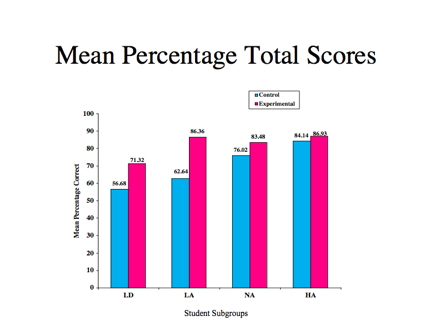Additional information
| Dimensions | 8.5 × 11 in |
|---|---|
| Cover | Paperback |
| Dimensions (W) | 8 1/2" |
| Dimensions (H) | 11" |
| Page Count | 56 |
| Publisher | Edge Enterprises, Inc. |
| Year Printed | 1995 |
| Requirements |
| Dimensions | 8.5 × 11 in |
|---|---|
| Cover | Paperback |
| Dimensions (W) | 8 1/2" |
| Dimensions (H) | 11" |
| Page Count | 56 |
| Publisher | Edge Enterprises, Inc. |
| Year Printed | 1995 |
| Requirements |
Overview
The Concept Comparison Routine is used by a teacher to help students understand the relationships between two concepts, particularly how the concepts are similar and different. This study investigated the effects of use of the Concept Comparison Routine on student performance. The instruction was provided by a researcher. A total of 107 students enrolled in 7th-, 8th-, 10th-, 11th-, and 12th-grade science classes participated. They were randomly assigned within their classes to participate in either an experimental or control group within designated subgroups: high achievers (HA), normal achievers (NA), low achievers (LA), and students with learning disabilities (LD). Fifty-five students were in the experimental group; 52 were in the control group. A lesson on two diseases, “malaria” and “snail fever,” was taught to the students. Experimental students were taught the lesson comparing and contrasting the two diseases with the Concept Comparison Routine. Control students were taught the same lesson with the same content using a traditional lecture-discussion method. A test, comprised of open-ended and objective questions, was given to all students on the content of the lesson on the next day.
Results
Results are shown in Figure 1 on the total test score for the student subgroups. A significant difference was found between all experimental and all control students’ scores in favor of the experimental group [F(1,99) = 20.53, p < .001, eta squared = .172]. This difference represents a large effect size. Moreover, a significant difference was found between the scores of the students with LD in the experimental group and in the control group [F(1,35) = 10.24, p < .003, eta squared = .226]. Again, this is a large effect size. A significant difference was also found between the scores of the low-achieving students in the experimental and control groups [F(1,14) = 8.39, p < .012, eta squared = .375]. Again, this difference represents a large effect size. Similar differences were found for the normal achievers, but no differences were found for the high achievers. All of the significant differences that were found were in favor of the Concept Comparison Routine instruction.

Figure 1: Mean percentage scores earned on tests by students with LD, low-achieving (LA) students, normally achieving (NA) students, and high-achieving (HA) students.
Conclusions
This study demonstrates that the Concept Comparison Routine, when used under controlled conditions, can enhance student learning and retention of information. In addition, it shows that students in different subgroups, including students with LD, low achievers, and normal achievers can benefit from the use of the routine. High achievers perform equally well when the routine is used and when lecture-discussion methods are used.
Reference
Bulgren, J. A., Schumaker, J. B., Deshler, D. D., Lenz, B. K. & Marquis, J. (2002). The use and effectiveness of a comparison routine in diverse secondary content classes. Journal of Educational Psychology, 94(2), 357-371.

Janis Bulgren, Ph.D.
Affliations
My Background and Interests
The focus of my research has been developing ways to help adolescents, including those with disabilities, succeed in inclusive general education classes. Having two degrees in English and teaching at the high school level for several years made me very aware of the needs of both teachers and students in diverse subject-area classes. This led to me to pursue a degree in special education from the University of Kansas. My combined background of general education and special education has allowed me to pursue my interests and insights about how teachers teach and how students learn. As a result, I have been privileged to work with teachers in a variety of subject areas and to do research on instructional techniques that support all students, including those who are low achieving, average achieving, and high achieving, as well as students with disabilities.
My focus has been on a programmatic line of research that builds upon a foundation of knowledge of factual information to create an understanding of critical concepts, to enable manipulation of information including making comparisons, analyzing causes and effects, weighing options to make decisions, and using reasoning to analyze claims and arguments. The goal of the instructional practices that I and my colleagues have designed is to guide students as they engage in deep learning and comprehension across subject-area domains and ultimately in the generalization of thinking to subject-area and real-world issues.
The Story Behind the Concept Comparison Routine
The development of the Concept Comparison Routine followed shortly after the development of the Concept Mastery Routine and the Concept Anchoring Routine, and it is a logical extension of understandings about how students learn. Although the exploration of characteristics and examples related to a major concept was a common and well-researched approach to helping students acquire an understanding about that critical concept, there appeared to be other paths for achieving this. One of these was teaching through comparing and contrasting. Therefore, the development of this routine was a logical next step in helping teachers as they ensured that students acquired knowledge, understanding, and use of critical concepts.
Indeed, the three routines, Concept Mastery, Concept Anchoring, and Concept Comparison, share common components. The most important of these is that key characteristics of a new concept are identified and highlighted by the teacher and students working together. With the Concept Comparison Routine, however, students learn about a new concept by building on characteristics shared and not shared by two or more concepts. In other words, through the use of this routine, students are building on their knowledge of concepts by determining how they are alike and different. As such, this routine brings richness into the learning process.
Moreover, this routine contributes to a series of instructional practices that support a taxonomic hierarchy of learning that is reflected in subject-area learning demands. This routine supports students as they acquire understandings of concepts, and these understandings may be applied to more complex and higher order thinking demands. This hierarchy of supports for thinking begins with facts and concepts, supports the manipulation of information, and finally leads to the use and generalization of important ideas and concepts.
My thoughts about Content Enhancement Instruction
Ideally, Content Enhancement Instruction involves the use of integrated sets of carefully planned instructional routines based on students’ needs and content-learning demands. This means that teachers use routines like the Course Organizer Routine, Unit Organizer Routine, and Lesson Organizer Routine to plan their courses and communicate to students about their courses. They use other routines, like the Concept Comparison Routine, as they are teaching the subject-area information. Through the use of several routines by teachers, students not only learn information, but they also progress to a higher level of thinking complexity. Our research has shown consistently that the performance of all types of students improves if the Content Enhancement Routines are used.
Teacher Feedback on the Concept Comparison Routine
Teachers were involved throughout the development and research associated with the Concept Comparison Routine. They provided direction and guidance to our team. During the development process, they told us that instruction on comparisons and contrasts often consisted of merely developing one list of similarities and another list of differences for students to remember. They indicated that they would value an instructional approach that would make learning more efficient and effective.
Once they used the routine, they reported that they appreciated the chance to help students acquire strategic thinking steps and to practice one of the most commonly required types of higher order thinking. They especially liked the opportunity to check students’ ability to transfer and generalize learning to new topic areas, something that is greatly emphasized in higher order thinking demands across the national content standards. Some of the participating teachers invented another use for the Comparison Table. They prompted students to use it as an outline while the students were producing written essays, and the teachers reported great improvement in student writing when they used the table in this way. This is just one of the many examples of how I continue to learn from expert content teachers.
Contact Information
Please contact me through Edge Enterprises, Inc. (877-767-1487).

 Concept Mastery Routine: Instructor’s manual
Concept Mastery Routine: Instructor’s manual